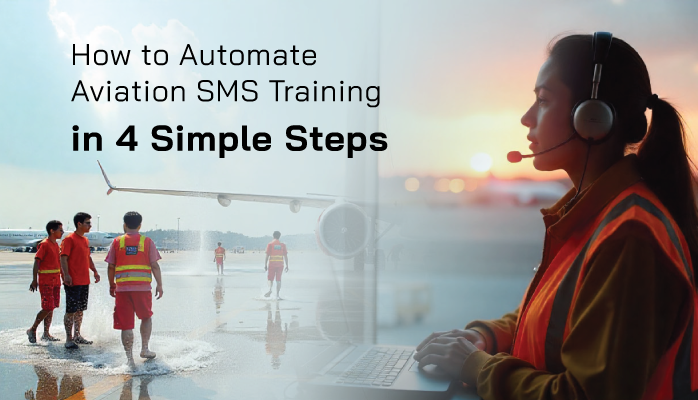Common Confusion Regarding Aviation SMS Training

Since November 2006, ICAO has mandated that aviation service providers implement formal aviation safety management systems (SMS). Among multiple operators that we have worked with, there has been confusion about:
- Who should participate in the aviation SMS;
- Who should receive SMS training;
- When must this training be delivered to employees;
- What topics must be covered in the SMS training;
- How often must SMS training be delivered to employees;
- What are the bare minimum requirements for SMS training; and
- What's the easiest way to comply with the aviation SMS training requirements?
Related Aviation SMS Training Articles
- What Is Aviation Safety Training in Aviation SMS - Includes Videos to Use
- Most Common Misconceptions About Aviation SMS Training
- 4 Pillars | 10 Things You Need to Know About Aviation Safety Training
Aviation SMS Training Not Same for All Employees
In an ICAO-compliant aviation SMS, there will be three specific times when aviation SMS training will be required during the implementation process:
- Phase II: Reactive Safety Management requiring aviation service providers to "Deliver training relevant to reactive risk management processes;"
- Phase III: Proactive and Predictive Safety Management requiring operators to "Deliver training relevant to proactive and predictive risk management processes;" and
- Phase IV: Operational Safety Assurance, which requires operators to "Develop training relevant to operational safety assurance"
The "reactive risk management training" in Phase I is not the same for all employees. All employees will need to participate in basic reactive risk management training, which consists primarily of:
- SMS fundamentals (purpose, structure, policies, responsibilities, etc.);
- Hazard identification; and
- Safety reporting processes.
In addition to the basics, safety managers, operational department heads, and executives will require additional training based on their role in the SMS. As an example, executives will need to learn how to monitor the performance of the aviation SMS, as accountable executives must regularly review safety performance.
Furthermore, operational department heads will need training on your organization's documented reactive risk management processes. The curriculum covered will certainly embrace how to manage assigned safety issues and their respective corrective actions and preventive actions.
Overlooking SMS Training Documentation

In Phase I, all employees will need SMS training to demonstrate:
- Employee understands how the organization's SMS operates;
- Employee is aware of their role in the SMS;
- Employee understands the SMS' purpose is to improve safety and not to attribute blame for honest errors or mistakes; and
- Each employee has participated in either a formal or informal induction of the SMS.
In the later phases of the SMS, the advanced training is mostly meant for managers and subject matter experts who are participating in proactive and predictive risk management processes.
Even for a small company with only one hundred employees, this training burden can cost considerable sums and take employees away from their revenue-generating duties. It is in the best interest of each aviation service provider to find an efficient and cost-effective way to both deliver and document employees' required SMS training. We must not forget to document all SMS training, as this has become a common audit finding when operators are unable to prove who and when employees have received their required SMS training.
So remember, not only must the organization develop the aviation SMS training but you must also
- deliver the training;
- document employees' participation in the training; and
- monitor employees' SMS training for expiration.
You may have initially thought that the SMS training requirement was rather simple, but it gets complicated rather quickly. This workload can be simplified by using aviation SMS database software to facilitate all these tasks.
Related Aviation SMS Database Software Articles
- What Is an Aviation Safety Database for SMS Implementations?
- 7 Signs You Need an Aviation Safety Management (SMS) Database
- How to Choose the Best Aviation Safety Database Software
Benefits When You Automate Aviation SMS Training
Delivering, documenting, and tracking aviation SMS training can be burdensome for organizations, both financially and logistically. As organizations grow, the logistical and financial headaches will become more pronounced, especially as resources are stretched thin.
The financial problem of aviation SMS training is not simply that training costs money, but it also pulls workers away from their duties that generate revenue that organizations depend upon to survive. Attempting to coordinate substitute personnel and training times is an additional logistical/financial burden. The answer to these burdens is to automate at a minimum your initial aviation SMS training requirements, and if you have the capabilities, also automate your recurrent SMS training.
You gain the following benefits when you automate aviation SMS training:
- Completely remove the logistical burden of aviation safety training;
- Save significant financial resources and overhead costs normally required for training;
- Let employees complete training at their convenience;
- Improved morale;
- Reduced risk of being in non-compliance; and
- Document/manage training outcomes for each employee, such as the end-of-training assessment scores.
With benefits like these, why don’t more companies adopt automated aviation safety training? Several reasons are:
- Fear of reliance on new technology;
- Ignorance as to the benefits/existence of automated training;
- Lack of financial resources or support to develop automated training; and
- Lack of knowing how to develop automated safety training.
The fourth point is particularly relevant. How do you automate aviation safety training processes? Here are 4 steps.
1 – Use Aviation SMS Database Software Technology

Practically speaking, you need to have some sort of modern database technology for automated training, such as:
- Aviation SMS point solution (i.e., technology that solves one specific task) for training; or
- Integrated aviation SMS software (i.e., technology that solves multiple SMS tasks and integrates them together).
Point solutions can provide a space for employees to:
- Review training resources, such as safety policies and procedures;
- Take assessment tests for the training resources; and
- Document training completion for each employee.
Aviation SMS software can do everything that a point-solution does, but additionally:
- Store training requirements for each role and automatically connect each role to relevant resources;
- Track training expiration dates for each employee based on their role;
- Remind employees of training and prompt them to start it;
- Generate trending reports for training assessment scores;
- Allows accountable executives to easily monitor SMS training progress;
- Integrate training resources with existing resources in the software tools, such as safety training articles, documents, etc.; and
- Document that each employee has actually reviewed those training resources.
Both software and point solutions will require an initial financial investment of some kind, which upper management will either refuse to do or be hesitant to do. If this is the case, you should easily be able to demonstrate the cost-benefit of automated training vs existing training in your organization. As a last resort, you may have to use spreadsheets, which are not an optimal solution for multiple reasons.
Related Articles on Using Spreadsheets in Aviation SMS
- 5 Things Spreadsheets Can’t Do for Your SMS
- Spreadsheets vs Software for Aviation Safety Management
- How Spreadsheets Not EASA Compliant Aviation Safety Reporting Database
2 – Compile and Organize All Training Materials
Next, you will need to organize all training materials and resources. What this means is:
- Reviewing training requirements for each role in your company;
- Gather all training materials and resources for each role, such as videos, duties/responsibilities, articles, documents, etc.; and
- Create a format for how you want employees to access these resources, such as what order each resource should be viewed in.
This task is the equivalent of creating a folder for each user role, and in each folder putting the relevant training materials. In the case of automated training, you are:
- Gathering these materials and placing them in an easily accessible folder on the company server, such as with point solutions; or
- Ensuring that the materials are available on your aviation SMS software and that each role can access relevant materials.
For example, with software, you might link to a particular document in your software, such as a quiz, whereby employees will click the link and the document will download onto the device they are using for training. Or with point solutions, you will direct each employee to the relevant document on the server to review.
3 – Decide When and How Aviation SMS Training Is Completed

Once you have training materials organized, you will need to decide when and how training is completed;
- With point solutions, you may have to manually track training expiration for each employee and each employee’s role; and
- With software, you will need to set recurring training time periods for each role, as well as assign relevant roles to each employee based on their responsibilities to the SMS.
Usually, when we are talking about automated training, this means:
- Initial SMS training when employees are first introduced to aviation SMS purpose and concepts;
- Initial training for the particular role when employees are assigned to a "safety management position" within the company; and
- Recurrent SMS training when employees re-take training after a set time period interval (i.e., 12 months or 18 months).
The difference between manual and automated aviation SMS training really stands out here:
- In systems with manual training, all of the above points will need to be organized, promoted, and facilitated by a person or team;
- In automated training, all of the above points are organized, promoted, and facilitated automatically by the integrated SMS training software.
Related Aviation SMS Software Articles
- 21 Benefits of Risk Management Software for Aviation SMS
- How to Choose Aviation SMS Software - Educating SMS Professionals
- How Does Aviation Safety Software Improve Safety?
4 – Create End of Training Course Assessments
End-of-training assessments should definitely be created when relying upon automated SMS training processes. These assessment tests:
- Ensure earnest participation by each employee in reviewing the training materials;
- Allow you to track the effectiveness of training for each employee overtime;
- Allow you to establish trends in the effectiveness of training for the whole company; and
- Provide an opportunity to analyze the connection between improvements/declines in training performance and improvements/declines in safety performance.
Each safety-related role in your aviation SMS should have an associated end-of-training test. Each test should be in direct response to the resources and materials that are made available for that role’s training.
As training materials are updated, the end-of-assessment tests need to be updated as well. This also has the secondary benefit of having the tests change over time, which is a natural barrier to complacency.
Organizations are recommended to require test proficiency scores for passing SMS training, especially for recurrent training. During the initial training process, safety managers must be alert to not overwhelm employees with difficult tests that could damage morale, and subsequently harm the safety reporting culture.
With SMS training software, these assessments will be naturally included in the training process. In addition to tracking training, SMS training software will also allow you to incorporate collected data into organizational key performance indicators (KPIs). You will only need to provide the questions, answer options, and correct answers and let the system do the heavy lifting.
Final Thoughts on Automating Aviation SMS Training Processes
Providing general SMS training does not have to be difficult or costly when using modern technologies. The money your organization saves from automating aviation SMS training will probably pay for the software acquired to deliver and document your SMS training.
For over a dozen years, SMS Pro has provided Web-based, aviation SMS software that not only addresses all of the required SMS documentation requirements but also makes delivering SMS training an incredibly simple and pain-free process.
To learn how your organization can benefit from low-cost, commercially available SMS software, please watch the following short demo videos.
Here is a great assessment test for the basics of risk management for aviation SMS applications.
Last updated in October 2025.









